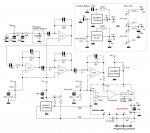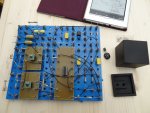New Pongsats planned: NLSE-2, 3 and 4 for 22 September Launch
Hello,
It has been a few years since our NLSE-1 (Pongsat-18X) near-Space Satellite was launched by JP Aerospace (
www.jpaerospace.com) and sucessfully operated, as reported in this thread.
In order to have a cool summer project activity we have enrolled in the upcoming flight, planned for 22 September, now with three Picaxe-based satellites (and two of my sons taking part in their design):
- NLSE-2: Gamma ray detection using a reverse-charged PIN-diode as detector (see also posts #51 and 52 in this thread for background info). Furthermore we want to study the picaxe's behaviour at very low temperatures (internal RC clock drift as compared to watch crystal oscillator, we are open to discussion of more interesting experiments for testing semiconductor behaviour at low temperatures)
- NLSE-3: "Atmospheric sensing" Pongsat with temperature, pressure, tilt/vibration (= wind speed measure)
- NLSE-4: An alternative - fun but somewhat crazy - way of measuring pressure decrease with height using a marshmallow-based home-brew pressure sensor! (since marshmallow is the most popular material flown in pongsats). We have an idea on how to do it, using a lemonade straw, marshallow filler in it, a miniature potentiometer and some stiff wire ... .
The one that is technically most challenging is of course the NLSE-2 (but in a sense also NLSE-4). For the gamma radiation circuit we plan to use a variant of the one presented in the Maxim Application Note AN2236, and our circuit then looks as follows:

The circuit front-end part with the PIN-diode detector and subsequent amplifiers IC1a-b and IC2a is identical with Maxim's AN. However, I altered the end stage containing the IC2b stage and IC3 comparator: we use a programmable noise canceler circuit using the Picaxe-14M2 internal comparator, DAC and SR-Latch as discussed elsewhere recently on this forum (will post the final version of the noise canceler in the code snippets section soon). Since the PIN-diode sensitivity is very temperature dependant we include a DS18B20 temperature sensor, and all data needs to be stored in an EEPROM as well. There are a number of questions we have and which we would like to discuss here, all related to the power delivery for this satellite:
1. The circuit above shows two variants: either a 3.6V special Lithium battery (same as NLSE-1 which worked very well) or a solar cell based solution. Since the PIN-diode needs a higher voltage (>=12V) and a sensitive 4-stage amplification circuit is used, I am a lttle afraid that the step-up coverter circuit as shown in the right-upper part of the circuit will generate too much switching noise. Would it still be possible to make it work? (we will start buiding a prototype soon and check it with Womai's oscilloscope) If so we still may get everything into a pongsat if Womai's offer of providing an industry-grade PCB still stands.
2. We may however also opt for a MiniCube version (a new offering by JP Aerospace, see their website), a 5x5x5 cm box which provides for space to fit solar cells on its surface. I guess that this then would allow a very smooth power provision (also shown in the circuit). I expect that due to the high efficiency of solar cells at low temperatures there would not be a need for any MPPT-like circuit for boosting their efficiency. With an effective area per side of 20 cm2 and five areas I would presume that such a setup would provide for enough power. Any opinions here?
Any suggestions, critical remarks etc. are most welcome
Enrollment in JPA's upcoming launch by sending John Powell a mail and one's own PongSat or MiniCube is still possible for other forum contributors as well ...
Best regards,
Jurjen


